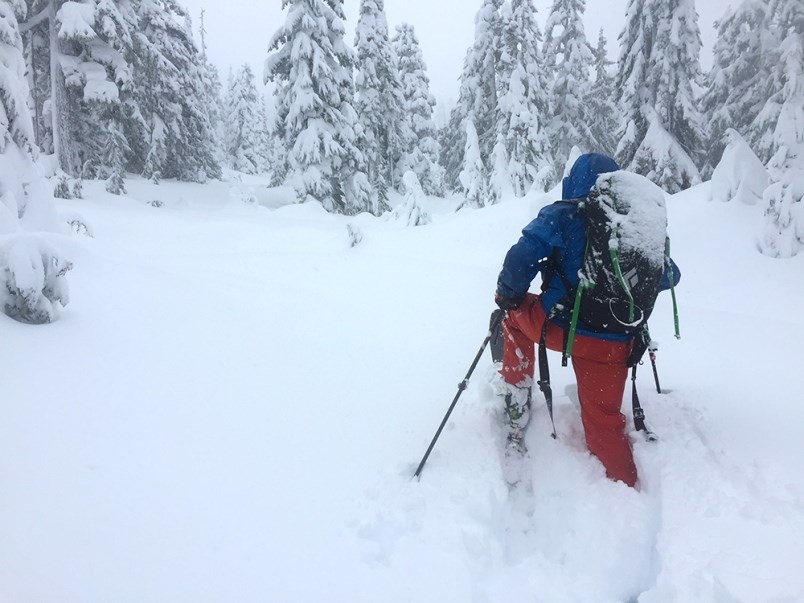A close call in the backcountry is serving as a valuable reminder for adventurers to remain vigilant.
On Monday, while seeking out fresh, untracked powder, a snowboarder fell into a sinkhole on the Red Heather Hut trail. Luckily, that person's head was still above snow, and a nearby party with avalanche rescue equipment was able to find and dig her out.
Sinkholes are created when running water gets covered by snow. While snow forms on top, the water carves out a pocket of air underneath that collapses when weight is applied from above.
The result is that a person can fall and get trapped underneath the snow.
The boarder escaped safe and uninjured, but it was a bit of a wake-up call for recreationalists, as Red Heather is often considered one of the easier backcountry routes. Some might even classify it as a bit of a gimme.
Jon Thorpe, a local who spoke to the parties involved, said there were multiple paths that diverged from the main route.
"There are a lot of various paths going through there," said Thorpe.
"I guess it was marked a little bit later this season so people would kind of pick their own ways down, so a lot of the paths don't go down or don't follow the marked line. And they just steered off a little bit. They saw some powder that looked pretty inviting and ended up in one of the creeks just below."
In this case, snow had blanketed a creek, creating a sinkhole that was not obvious to the naked eye.
Thorpe, a backcountry skier with four years' experience, said that the incident serves as a reminder to be prepared with avalanche AST training and rescue gear, even in relatively easy terrain.
This would include gear like a shovel, a beacon and a probe.
Another big factor was that the person who was with the fallen rider had an eye on her the whole time. This made locating her much simpler, he said. It's especially important to keep an eye on each other when riding in treed areas.
Thorpe also warned that it's best to stay in main routes that are well-tracked. Those who veer away from the beaten path had better know where they're going.
Sandra Riches, executive director with BC AdventureSmart, a backcountry safety education group, said that there are three things that people should take into account before going on any trip.
She calls them the three Ts — trip planning, training, taking essentials.
"A lot of the incidents during the winter have been based on injury, lost and disoriented and exceeding abilities — those are our Top 3, if you will, for winter causations," said Riches.
It all starts with planning things out to a tee on your kitchen table.
Riches said you should establish an emergency contact who has detailed knowledge of the gear and food you have with you, who and where you're going with, and when you're expected to return.
That way, someone can sound the alarm in a worst-case scenario where you can't contact search and rescue yourself.
Riches said this process can be made easier by using the BC AdventureSmart trip planning app.
Having the right skills like orienteering, avalanche skills training and wilderness first aid are necessary, she said.
People finding themselves in a tough spot need to stop and assess the situation, figure out a plan, see if anyone's injured, and devise a way to communicate with search and rescue if necessary, she said. Then people need to assess how to stay warm, dry and fed during the wait for help.
In the case of someone falling in a sinkhole, rescue parties would first want to consider carving a safe path to the person who has fallen, Riches said. It's important to make sure rescuers themselves are in a safe position first.
People should also have safety whistles on them in a place close to their mouths, as voices can grow hoarse and get lost in the wind, she added.
Finally, she noted that most calls come between 3 p.m. and 7 a.m., and the average search and rescue response takes eight hours, so adventurers should have the gear and food to spend a night and stay warm and dry.
BC AdventureSmart is also hosting snow safety programs every other week starting Jan. 6.
January 6, 2021: Snow Safety Education - Backcountry
January 20, 2021: Snow Safety Education - Inbounds
February 3, 2021: Survive Outside Program
February 17, 2021: Snow Safety Education Program - Backcountry
March 3, 2021: Survive Outside Program
March 17, 2021: Snow Safety Education - Backcountry




